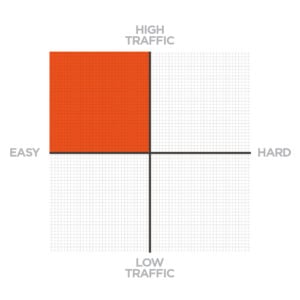In Part 1 of our 3-part series, we talked about how organic search (SEO) doesn't just happen by accident. It has to be approached purposefully. What does that mean? For starters, it means you need to have a plan. There are numerous ways to approach planning an organic SEO program, here's a peek at how we tackle search for clients.
Which search terms are you being found for today?
The first step to determining an SEO strategy is to understand how people are finding you today. A few years ago, Google stopped sharing organic keywords through Google Analytics—so it's not as easy as checking your own data. Up to 99% of organic keywords can be missing in Google Analytics.
Fortunately, there are other ways to find out how you're being found.
Google Ads
The fastest and easiest way to understand what keywords might be relevant to you is to leverage your paid Google Ads (if you are running them) to help determine your SEO strategy. It stands to reason that people clicking on your listing in a paid search ad would also be likely to click it in an organic search result.
Moreover, studies have shown that people are up to 3x more likely to click an organic search result if they also see an ad for the company on the same page. Running your ads gives you legitimacy. Having an organic result on the same page increases your chance of being seen—and having someone act.
Search Engine Ranking Tools
Although Google removed organic search keywords from Google Analytics, many 3rd party companies have built their business around developing tools that analyze search terms and website ranks. These tools generally offer a free look at a piece of your organic search results, but for a full version, you have to pay.
We have a broad license to one such tool that allows us to analyze client websites, their competitors websites, and determine who is ranking for what terms—and what we want to rank for moving forward.
Which search terms are most valuable for you?
Once we understand what a client ranks for already, we can analyze those terms to see if they're of value. We can also look at competitor terms, and broader related terms to see what the client should be ranking for. To do that we analyze a variety of factors:
Traffic for the keyword
We want high traffic keywords if we're going to spend time and money trying to rank for them.
Level of difficulty
Is the keyword hotly contested? Is there a strong likelihood we can make it to page one or is that a pipe dream?
Relative cost of paid search
Although we're working on an organic search strategy, we also look at the cost to buy the term in Google Ads. Purchasing terms in
Google Ads can be a great shortcut to ranking—and will ultimately help your organic rank as well.
We're looking for terms that are high traffic, low difficulty to find that sweet spot to launch an SEO program. These will provide us with the most bang for our buck as we're trying to rank.

Putting it all together
Once we have the keywords mapped out, we look develop a website and social media content plan to help drive our clients' company higher in search results. We then track up to 25 keywords on a monthly basis to look for movement for both clients and their competitors.
Our goal is to see continuous movement—even if a keyword starts at rank 99 for a client, seeing it move to 72, then 60, then 36 shows we're making progress. Once we reach the top page of search results, we work to keep that keyword there—and monitor for threats.
If you're interested in seeing how your website looks to Google search users, get in touch with us. We'd love to talk. In Part 3 of this series, we'll share some examples of how our clients have seen success with our proven strategies and implementation.





